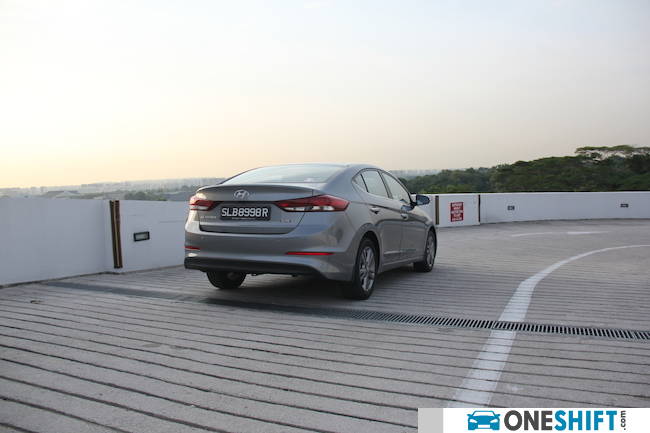EDITOR'S PICKS - Compact Sedans Below 100k
Just like how rice is a staple diet, sedans have become an evergreen body shape. The three box designs may not have the same draw as say a crossover or a coupe, but why do they draw buyers? While some may say that the sedan has lost some of its appeal, one cannot deny that the practicality of these cars, together with competitive pricing is generally hard to beat. Here are 4 compact sedans we feel are ideal for those looking to stretch their dollar!


Just like how rice is a staple diet, sedans have become an evergreen body shape.
The three box designs may not have the same draw as say a crossover or a coupe, but why do they draw buyers?
While some may say that the sedan has lost some of its appeal, one cannot deny that the practicality of these cars, together with competitive pricing is generally hard to beat.
Here are 4 compact sedans we feel are ideal for those looking to stretch their dollar!
The new Vios according to Chief Designer Takatomo Suzuki, is a new value pioneer – an innovative and quality new model designed without compromise.
The new car is the widest in its class at 1,730mm, meaning better shoulder room on the inside. Newly redesigned seats in the rear, aid in passenger comfort. While comfort has been improved, leg room in the rear is good enough for the average adult.

As compact sedans go, the Vios is a practical car, with 506 litres of cargo room in the rear, enough for dropping an un-deployed child’s seat, and then some shopping. Rear seats do fold on the G model, although not flat, to accommodate more.
The new dash is pleasant, with materials and especially fit an improvement from the previous generations of Vios models. Like the car it replaces, Toyota had kept to keeping the simple and easy to read instrument binnacle in-front of the driver, where it should be. Driver comfort is helped by a tilt steering wheel adjustment.

Powered by a 1.5 litre Dual VVT-I engine, and delivering a decent 105bhp, the new Vios ditches its proven but dated 4-speed automatic, and in-place utilises a smooth Continuously Variable Transmission (CVT) with seven virtual ratios. Toyota is one of the manufacturers we feel who have gotten the formula for their CVT correct, where most units tend to hold down to lower ratios for way too long under harder acceleration, the Toyota CVT on the other hand tends to “shift” upward to higher ratios more quickly, improving response and definitely fuel economy; and is further improved with Low Rolling-resistance Coefficient (RRC) tires. Fuel economy is a healthy 17.2km/l.

Two variants are on sale, the E-grade which retails for $84,988*, while the more luxurious G-grade which gets 16” rims and rear discs retails for $89,988*.

Between the two cars, the E-grade model is easier to live with, not just from a price point, but with smaller rims, comes cheaper tyres, and U-turns are also marginally easier with a smaller turn radius of 5.1m versus 5.7m on the G-grade.
Almost like a miniaturised, previous model Vios from some angles, the Bezza is a small sedan produced by Malaysian manufacturer, Perodua.
Under the hood, the Bezza gets a Toyota-developed 1.3 litre engine, complete with Toyota’s famed Dual VVT-I technology.
Other features include goodies like push-button engine start, and Bluetooth connectivity for mobile devices, turn signal repeaters on the wing mirrors and driver-side smart entry. Little touches like a thoughtful mobile phone slot for rear passengers, with a USB port for charging, jam-protected power windows, and front corner sensors adds to value.

Boasting a respectable 508 litres of cargo space, the Bezza is actually quite the practical car for those who may be looking for their first set of wheels.
With the Premium X (Auto) model going for $77,800*, the Bezza is one of the most affordable new cars on our roads. One final statement… Four cylinders.

Packing in the frills, Hyundai’s Elantra is one of the cars which you can easily associate bang-for-buck with. While the compact sedan has seen improvements over the years, more recently, the Korean company had taken efforts to simply offer more frills, especially with creature comforts, and in terms of safety.

Under the hood, a 1.6 litre engine, good for a respectable 125bhp, and delivers power to the front wheels, via a 6-speed automatic transmission.
From added chrome for a more expensive look, to a generous 2,700mm wheelbase, for more passenger room, to their convenient smart boot function, making cargo access easier, the Elantra makes a strong argument with space and a long list of equipment. Other hidden goodies, like a full-sized alloy spare tyre adds to value, and peace-of mind, especially when going on longer trips. While driving dynamics does take a step back with the Korean car, passenger comfort comes across as a more important factor.
In speaking about comfort, driver and front passenger seats benefit from air-conditioned seats. Fit and finish of the dash is remarkably good, with a well-placed and purposeful button layout. For added ease of driving, the Elantra is also fitted with blind spot detection and a factory-fitted reverse camera for assistance in parking.

While the Korean manufacturer is able to present a car which is able to do it its way, versus the likes of the venerable worlds-best-selling Corolla; and even with frills in, the GLS Elite model we tested goes for $87,999*, complete with 16” alloys. Quite a bit less coin than its Thai-built Japanese competition.
While their 2 hatchback model is a more popular offering, Mazda’s smallest sedan offers more practical cargo space... good for young families.
Like their larger cars, the Mazda 2 prides itself with very good build quality, and it shows with its refined interior fit and finish. A 1.5 litre SKYACTIV engine, with a 6-speed automatic drives the 2, delivering a respectable 148Nm of torque. While the Japanese manufacturer’s emphasis is on quality of their build, we would feel that the engine could be a little more refined.

Though easy to use, the operating system of the infotainment unit could do with a design refresh, as it does come across as a little dated.
Mazda’s innovative G-Vectoring Control technology has also found its way into the 2, meaning improved ride and stability, by way of minor adjustments to engine torque, which adjusts the car’s shift in weight when cornering.

Other goodies include a wide angle reverse camera to aid in parking. Luggage accommodation is not the best in its field, but still a practical 414 litres, thanks to the sedan’s rear-ward expansion.
The 2 Plus Sedan now retails for $78,800*.
The Vios was Toyota’s necessary compact car, as the Corolla gradually made its way upmarket. In its 4th generation, the Vios delivers well on a good amount of practical passenger room and cargo space.
Features like curtain and knee airbags add to an already comprehensive list of safety equipment, and for ease of usage, the Vios even boasts Hill-start Assist Control (HAC).
While the 1.5 litre engine may not deliver on outright performance, the CVT transmission is very well sorted out, and if you want a frugal-yet-well-built bit of Japanese engineering, the Vios certainly is an appealing buy.
Bang-for-buck. More frills mean more value. We certainly love the ventilated front seats. But where it counts, is that from a price point, there are only a few cars which are kitted out this well, without compromise on size.
As we did mention, the Elantra is no driver’s car, but one which could satisfy the value-conscious buyer.
*prices correct at time of publication
Credits:








Get the Best Price for your used car
from 500+ dealers in 24 hours

- Convenient and Hassle-Free
- Consumer Protection
Transparent Process
With No Obligation








